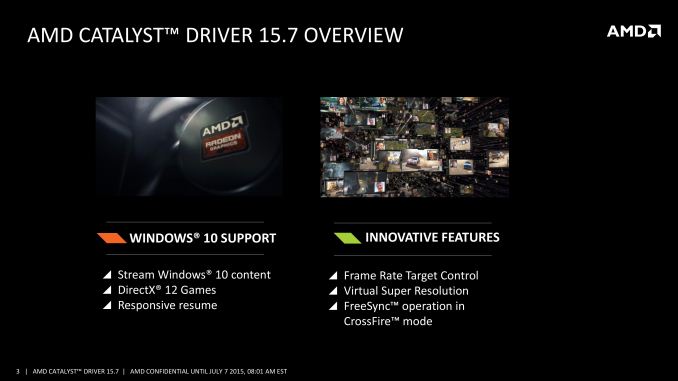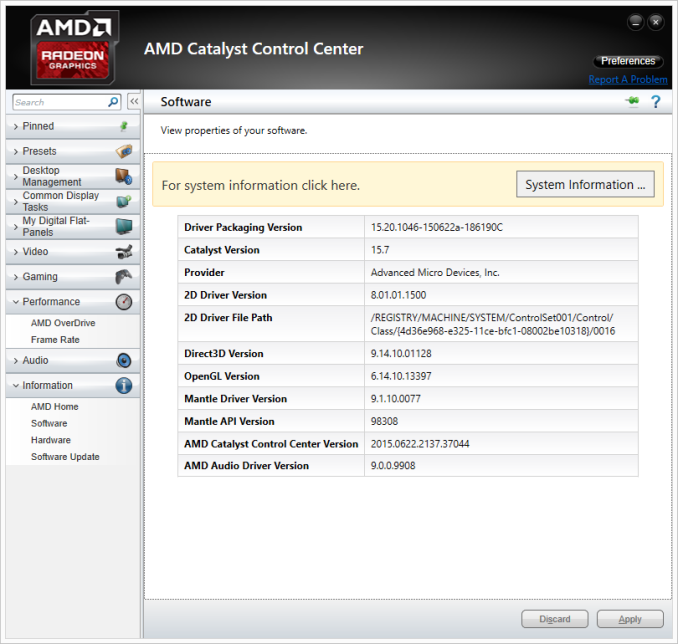AMD Releases Catalyst 15.7 WHQL Drivers: Crossfire Freesync, Win10 Support, & More
by Ryan Smith on July 8, 2015 7:40 PM EST- Posted in
- GPUs
- AMD
- Radeon
- Drivers
- Radeon 200
- Windows 10
- Radeon 300

After a brief detour for AMD’s driver team where they diverged their drivers for the Radeon 300 series and R9 Fury X launch, AMD has reunified their drivers with the release of Catalyst 15.7. The WHQL release, the first such release from AMD since Catalyst 14.12 in December, includes a number of major feature additions and performance improvements relative to both the previous 15.6 drivers for AMD’s older cards, and the even older 14.12 WHQL drivers.
Overall here are the major additions to AMD’s drivers that Radeon owners will want to be aware of:
- Performance improvements for older cards
- Frame Rate Target Control for older cards
- Virtual Super Resolution has been extended to the 7000 series and AMD APUs
- Crossfire Freesync is now supported
- Preliminary “technical preview” Windows 10 support (WDDM 2.0)
The driver build, 15.20.1046, is based off a slightly newer branch than the one used for the 300 series launch (15.15). As that driver already incorporated most of these improvements, for new 300 series owners the changes compared to the 15.15 launch driver will be minimal other than the fact that WDDM 2.0 drivers are now available.
As for existing Radeon owners, this means that the functionality that was previously limited to the latest Radeon products has finally been backported. Frame Rate Target Control, which allows capping framerates between 55fps and 95fps, is now available on most GCN cards. And Virtual Super Resolution, previously only available on certain members of the 200 series, has been backported to all Bonaire, Pitcairn, and Tahiti GPUs, meaning that the R7 260 Series, HD 7790, HD 7800 series, and HD 7900 series all support VSR. So do AMD’s latest APUs, with the 7400K and above getting VSR support.
Meanwhile Crossfire Freesync, after being held back by AMD earlier this year due to outstanding issues, has finally been enabled. We have not had a chance to test this yet to see how well it works, though AMD notes that it’s working for DirectX 10 and higher (which implicitly excludes DX9 and OpenGL applications).
As for performance for older cards, we’re still running numbers, but for the games in our benchmark suite it looks like there are consistent performance gains in The Talos Principle, with further minor upticks in performance in Total War: Attila, and in the minimum framerates for Shadows of Mordor. AMD’s notes also mention a number of new Crossfire profiles, though this is relative to the 14.12 release. Finally, since I’ve had a few people ask me about this, according to AMD’s notes they have not yet resolved the anti-aliasing corruption issues with Crossfire in The Witcher 3.
Last but not least, AMD has also released a Windows 10 driver package that includes WDDM 2.0 and DirectX 12 support. While earlier driver releases were available through Windows Update, this is the first external WDDM 2.0 driver release for the company, and the first WDDM 2.0 driver to support recent products like the R9 Fury X. For the moment AMD is covering their bases and calling this a “technical preview” driver, with official driver support to come on the 29th when Windows 10 launches. The driver is for all GCN video cards, as older Radeon 5000 and 6000 products will not be getting WDDM 2.0 support and will continue using the existing WDDM 1.x drivers on Windows 10.
Finally, for this driver release you’ll want to check out AMD’s master driver download page. The company has released individual driver packages for Windows 7, Windows 8.1, and Windows 10 (in both 32-bit and 64-bit varieties), so you’ll want to grab the right package for your operating system.
Source: AMD











68 Comments
View All Comments
freeskier93 - Wednesday, July 8, 2015 - link
Downloading now! Hopefully though Windows Update doesn't try to revert it back to the "engineering sample" driver on W10...Jtaylor1986 - Wednesday, July 8, 2015 - link
FRTC seems to be completely broken in Dragon Age Inquisition for me no matter the setting or API. What gives?AS118 - Thursday, July 9, 2015 - link
Are you using Mantle? If so, try DX11. If you're on DX11, try Mantle. If that doesn't fix it, I recommend going to AMD's support forums.Jtaylor1986 - Thursday, July 9, 2015 - link
The problem is the frostbite internal fps counter doesn't work with it. FRAPS seems to show the cap as workingAS118 - Thursday, July 9, 2015 - link
Ah cool, thanks for the tip. Now I know to use FRAPS to test it with DAI. Now if only I could find out what the issue is with FRTC and Marvel Heroes. I've got 120+ FPS according to FRAPS.Gigaplex - Wednesday, July 8, 2015 - link
Let's hope this driver fixes the occasional BSODs and graphical corruption on the desktop I get when coming out of power management modes (screen sleep, system sleep).zodiacsoulmate - Thursday, July 9, 2015 - link
I have that too on the firepro M4000.... have never solved itAS118 - Thursday, July 9, 2015 - link
If you haven't cleaned the inside of your PC out in a while, dusting it out and such may help. Other than that, I can't really offer any advice besides uninstalling and reinstalling drivers, or swapping out your PSU if you have a cheap no-name PSU.Crappy PSU's and motherboards cause so many problems that a surprising amount of people don't know about.
Gigaplex - Thursday, July 9, 2015 - link
Quality Silverstone PSU, Asus P8Z77-I motherboard, system is clean and the issue has occurred on multiple AMD cards (7770, R9 270X). I'm not sure why you automatically assumed dust (and therefore heat) was a likely cause in low power usage situations.looncraz - Thursday, July 9, 2015 - link
You have an odd problem, though not an entirely uncommon one. However, it is a problem that I have never seen on a GCN GPU, the old VLIW GPUs were notorious for standby/resume issues.I would suggest using DDU and wiping the drivers completely clean and reinstalling the latest version. I also found that setting a low idle clock overdrive profile helped, though you would have to remember to disable overdrive before gaming (I set up Ctrl-Shift-1~4 for different profiles, 1 being idle, 2, being light gaming, 3 being moderate gaming, 4 being turn off overdrive).